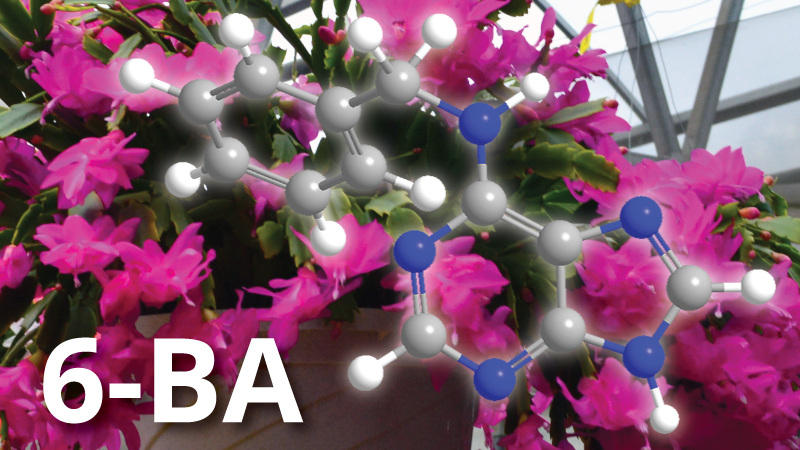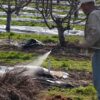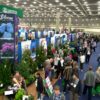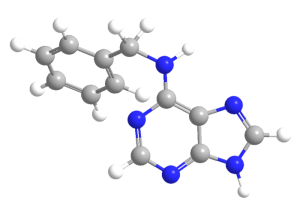
6-benzyladenine (6-BA) is the active ingredient of CytoFlor, a cytokinin PGR.
The CytoFlor plant growth regulator is the newest member of the ornamental and nursery product portfolio of Mycorrhizal Applications. CytoFlor contains 6-benzyladenine (6-BA), a cytokinin plant growth regulator, as its active ingredient, and can be successfully used to increase aesthetic characteristics of ornamental plants by improved plant architecture, increased flowering habit, and providing fruitlet removal.
Cytokinins are one of the most important groups of chemicals in regulating development and growth in plants. Cytokinins play an essential role in plant development throughout the life cycle, ranging from the germination of seeds to vegetative and reproductive growth, to fruit set. Below, we review the three most important commercial uses of CytoFlor; increased lateral branching, increased flowering, and removal of undesired fruit from ornamental flowering trees.
- Increased Lateral Branching
Plants that normally produce few branches during production can be encouraged to branch with cytokinins. Many plants have to be manually pinched, pruned, sheared, or disbudded during production in order to stimulate branching. This is a time-consuming and therefore expensive procedure. CytoFlor stimulates lateral branching and represents a chemical alternative to mechanical pinching/shearing in ornamentals, non-edible plants and non-bearing fruit trees. Lateral branching is induced by the activation of dormant axillary buds. For this use, CytoFlor can be applied at a rate of 50-500 ppm as a foliar spray or drench treatment. Multiple applications can be made if a single application does not provide the desired efficacy. In these cases, it is recommended to allow 7-10 days between applications to observe the efficacy of the previous application and to avoid phytotoxicity. Due to the increased resource allocation to a greater number of lateral branches, CytoFlor may reduce growth rate/overall height of the plant resulting in a more compact and marketable plant and faster pot fill.
An exception from the above use rates is in plantain lily (Hosta) varieties, were application rates range from 1,000 to 3,000 ppm. These applications can increase lateral growth and offset production. For commercial growers, a Hosta with more basal branches will appear fuller and be perceived to have a higher quality compared to a Hosta with only a single stem in the pot. One of the essential keys to improving branching with CytoFlor on Hosta is to make the applications when the plants are actively growing. The use of CytoFlor in Hosta is limited to nurseries, greenhouses, and field applications by manually pressurized hand wand or ground boom.
Besides the increase of lateral branching, CytoFlor can improve branch angles in some narrow-angled woody crops, such as Bradford pear (Pyrus calleryana), when applied at 50-500 ppm rate. This effect could apply to other ornamental woody plants to improve branch angles during production and thus enhance retail quality and landscape aesthetics.
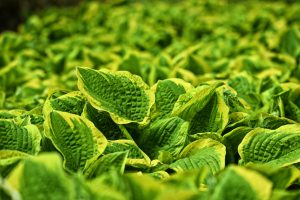
6-BA increases lateral branching and overall marketability of hostas and many other ornamental crops and bedding plants.
- Increased Flowering
In many plants, increased branching by CytoFlor results in increased flower number and flowering due to the increased number of branches/offshoots. This is very important in plants such as Calibrachoa, Gaillardia, or Phalaenopsis orchids, where the greater number of flowers per plant is a highly desired trait by the customer. For this purpose, CytoFlor can be applied in plug flats, liners, or to finished plants when plants are actively growing. Plants have to have available lateral buds and sufficient stem development to support branching. Application rate ranges from 50 to 500 ppm and can be applied either foliarly or as a soil drench. 6-benzyladenine does not readily move within the plant, therefore complete coverage is required when applied as a foliar spray. For successful drench applications, plants have to have good root growth.
One of the most common uses of CytoFlor to increase flowering and flower bud formation is in Christmas cactus. The use rate is specific to this species between 100 and 200 ppm.
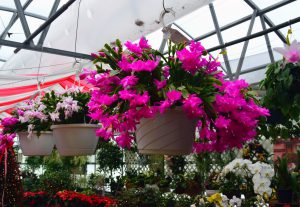
6-BA increases flowering in many ornamental and greenhouse crops, including Christmas Cactus.
- Removal of Undesired Fruit from Ornamental Flowering Trees
Chemical induction of fruitlet abscission with the use of 6-BA is well known and has been used commercially in apple and pear production for decades. Therefore, it comes as no surprise that CytoFlor is an excellent tool to induce abscission of apple and pear fruit from ornamental nursery trees. The flowers of these trees represent the main aesthetic value, and it is often desired that these trees do not retain their fruit after flowering. CytoFlor, at 50-200 ppm rate, can be applied as a foliar spray after flowering when fruitlets are still young, normally within three weeks of flowering. Applications will be the most effective when the maximum temperature is above 65°F on the day of application and the following 2-3 days.
Before using CytoFlor in your operation, please, read the label instructions on product application and personal protective equipment. First-time users of CytoFlor should determine the appropriate rate and application timing by conducting trials on a small number of plants to determine crop response and cultivar sensitivity. It is recommended to consult your local Mycorrhizal Applications Agricultural Specialist (866-476-7800) for specific information regarding the use of this product in your particular nursery.
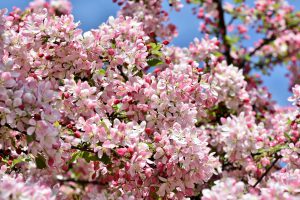
6-BA removes undesired fruit from ornamental fruit trees.
6-BA Horticulture Products:
CytoFlor is produced by Valent BioSciences, a leader in the PGR field, and their formulation has been proven in agriculture for its superior efficacy and absorption rate. The faster the product absorbs, the faster it can go to work, and the less product runs off of the foliage and away from the plant:
Article by: Jozsef Racsko
Mycorrhizal Applications – Technology Manager
May 18, 2020

